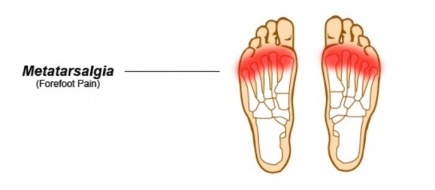Unlock the secrets to overcoming Metatarsalgia with our expert guide. Dive into the symptoms, causes, and cutting-edge treatments for this foot condition. Learn how to alleviate pain, choose the right footwear, and embrace a lifestyle that supports optimal foot health.

Introduction
Metatarsalgia, characterized by pain and inflammation in the ball of the foot, presents a challenge to those it affects, often likened to the sensation of walking with a pebble in your shoe. This comprehensive guide delves into the nuances of Metatarsalgia, shedding light on its symptoms, underlying causes, and the spectrum of treatments available. From lifestyle adjustments to advanced medical interventions, we explore effective strategies to manage this common yet debilitating foot condition.
Table of Contents
Understanding Metatarsalgia
Metatarsalgia, a condition marked by pain and inflammation in the ball of the foot, affects the metatarsals, the bones that connect the ankle to the toes. This condition can make daily activities such as walking and standing quite uncomfortable, often described as feeling like a pebble is stuck in your shoe. Here’s a detailed exploration of Metatarsalgia, including its symptoms, causes, and how it can be effectively managed.

Symptoms
Those suffering from Metatarsalgia may experience:
| Sharp, Aching, or Burning Pain: Primarily located in the ball of the foot, the intensity of this discomfort can vary. |
| Pain That Worsens with Activity: Standing, walking, or running can aggravate the pain, whereas resting tends to offer relief. |
| Increased Discomfort from Certain Footwear: Tight or high-heeled shoes can amplify the pressure on the ball of the foot, intensifying the pain. |
| Tingling or Numbness: A loss of sensation in the toes may accompany the pain for some individuals. |
| Feeling of a Pebble in the Shoe: A distinctive symptom where sufferers feel as though something is perpetually under their foot. |
Causes and Contributing Factors

Metatarsalgia arises from various conditions that place excessive stress or pressure on the metatarsals. Significant factors include:
| High-Impact Sports: Engaging in activities that involve significant force on the forefoot, such as running or jumping, can lead to inflammation and discomfort. |
| Foot Deformities: Structural issues like high arches or hammertoes can disrupt weight distribution across the foot, adding stress to the metatarsals. |
| Excess Weight: Increased body weight elevates the pressure exerted on the foot with each step, potentially causing Metatarsalgia. |
| Inappropriate Footwear: Ill-fitting or unsupportive shoes can increase forefoot pressure, exacerbating pain. |
| Aging: Natural decreases in the protective fat pad of the foot over time can heighten susceptibility to Metatarsalgia. |
Diagnosis
Metatarsalgia, characterized by pain in the ball of the foot, requires a thorough approach for diagnosis and treatment. Here’s an in-depth look at how healthcare professionals identify this condition and the various treatment options available to alleviate discomfort and restore foot health.
Review Medical History and Symptoms
A healthcare provider will begin by discussing your medical history and specific symptoms to identify potential contributing factors.
Physical Examination
An examination of the foot will be conducted to assess tenderness in the metatarsal area, looking for signs of inflammation and any deformities that may be worsening the condition.
Imaging Tests:
X-rays or other imaging techniques are often used to rule out fractures, arthritis, and other conditions that could be causing symptoms similar to Metatarsalgia. MRI scans might be recommended for a detailed evaluation of the foot’s soft tissues and bones.
Treatment Option
Treatment for Metatarsalgia ranges from conservative methods to more advanced interventions:
Conservative Treatments
Rest and Ice: Reducing activities that aggravate the pain and applying ice packs can help decrease inflammation and discomfort.
Footwear Adjustments: Opting for shoes with ample toe space and low heels, along with using orthotic inserts, can alleviate pressure on the metatarsals.
Weight Management: Losing weight can lessen the burden on the feet for those where excess weight is a contributing factor.
Exercises: Engaging in specific exercises to strengthen and stretch the foot can improve foot mechanics and reduce metatarsal strain.
Advanced Treatments
Physical Therapy: Customized exercise programs aimed at strengthening and increasing flexibility can address foot imbalances, providing lasting relief.
Medications: Nonsteroidal anti-inflammatory drugs (NSAIDs) like ibuprofen may be used to manage pain and inflammation during acute episodes.
Surgery: For cases unresponsive to conservative treatments, surgery might be necessary to correct structural deformities contributing to Metatarsalgia.

Enhancing Awareness of Metatarsalgia
Educating oneself about Metatarsalgia, including its causes and early symptom recognition, is crucial for timely intervention. Adopting preventive measures, such as selecting suitable footwear and maintaining a healthy weight, plays a significant role in mitigating the risk of developing this condition. Awareness and proactive management are key to overcoming Metatarsalgia and ensuring foot health.
Frequently Asked Questions
Q: What exactly is Metatarsalgia?
A: Metatarsalgia is a condition marked by pain and inflammation in the ball of the foot, affecting the metatarsals, the long bones in the foot that connect the ankle to the toes.
Q: What are the main symptoms of Metatarsalgia?
A: Symptoms include sharp, aching, or burning pain in the ball of the foot, pain that worsens with activity, increased discomfort from certain footwear, tingling or numbness in the toes, and the sensation of a pebble in the shoe.
Q: What causes Metatarsalgia?
A: Causes range from high-impact sports and foot deformities to excess weight, inappropriate footwear, and the natural aging process.
Q: How is Metatarsalgia diagnosed?
A: Diagnosis involves reviewing medical history and symptoms, a physical examination of the foot, and imaging tests like X-rays or MRI scans to rule out other conditions.
Q: What treatment options are available for Metatarsalgia?
A: Treatments include conservative methods like rest, ice, footwear adjustments, and exercises, as well as advanced treatments such as physical therapy, medications, and possibly surgery for severe cases.
Conclusion
Metatarsalgia, while painful and potentially disruptive to daily life, can be effectively managed with the right approach. Understanding the condition, recognizing its symptoms early, and adopting both preventive measures and appropriate treatments are crucial steps toward alleviating pain and restoring foot health. Embrace the journey to foot wellness with confidence, supported by the insights and strategies outlined in this guide.



MOST COMMENTED
Animal-Based Proteins / Casein Protein / Dietary Protein / High-Protein Diets / Pea Protein / Plant-Based Proteins / Protein / Protein Deficiency / Protein Supplements / Proteins / Whey Protein / Whey Proteins
Is Protein Powder Safe for Teenagers and Children?
Animal-Based Proteins / Casein Protein / Dietary Protein / High-Protein Diets / Pea Protein / Plant-Based Proteins / Protein / Protein Deficiency / Protein Supplements / Proteins / Whey Protein / Whey Proteins
Unlock the Power of Proteins for Optimal Gut Health
Multivitamin
Total Health: Multivitamin for Active Lifestyles
Multivitamin
WellnessFusion: Complete Multivitamin Support
Dietary Supplement
Revitalize Your Health: The Magic of Red Yeast Rice Capsules
Foot care / Foot Health
Revitalize Your Foot Care Routine: Essential Tips for Optimal Foot Health
Foot Problem / Diabetics / Foot Health
Diabetics: Mastering Footwear Selection for Enhanced Foot Health and Ultimate Comfort
Exercises and Footwear Tips for Hammertoe Relief / Foot care / Foot Health / Foot Pain / Foot Problem / Hammertoes
Unlock Effective Exercises and Footwear Tips for Hammertoe Relief
Hammertoes / Foot Health / Foot Pain / Foot Problem
Unlock Relief: Essential Guide to Hammertoes Causes, Symptoms, and Treatments
Foot Problem / Foot Health
Revolutionize Your Recovery: Natural Remedies for Plantar Fasciitis – Fresh Home Keepers